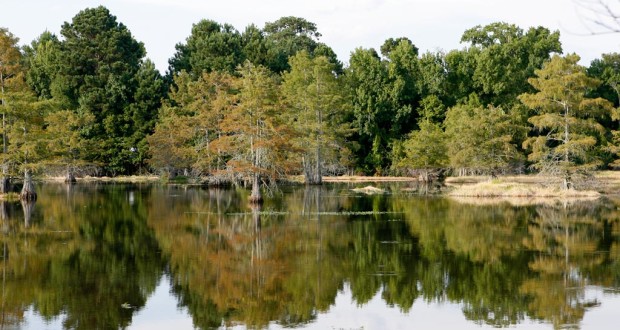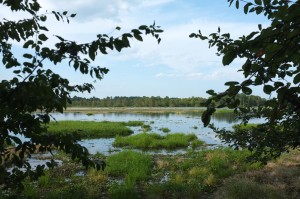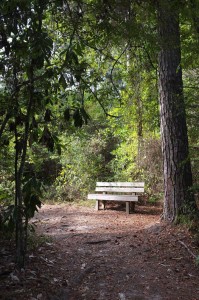The watery park’s 705 acres are divided into three sections – the Hen House Ridge area with the park headquarters, the Walnut Ridge area down the road and the small Cherokee picnic area on the other side of the reservoir. Even the drive across the causeway to the main areas of the park is pleasant, particularly near dawn and sunset, when the lake is calm and its isolated trees and patches of grass are bathed in golden light.
Five main trails cross the park’s islands and peninsulas:
- Slough Trail (2.27 miles – Hen House Ridge) Begin at the trail head just past the bridge and floating dock on the slough. From there, the broad trail heads south and briefly touches the shore of the lake before turning back inland for about a mile. Tall pines loom above, mixed with oaks, beeches and blackgum, whose leaves blaze in color in the fall. As the north end of the trail turns back toward the road it enters a dense woodland along a swampy slough. This stretch is the highlight of the trail, crossing short bridges and graying boardwalk planks. Cypress trees with their knobby knees poke through the green blanket on the water during the summer. From there, the trail returns along the park road, but it’s a quiet walk with enormous pines on either side.
- Forest Trail (1.35 miles – Hen House Ridge) The trail begins near the park’s headquarters and is a good choice if you’re just looking for a lazy walk through the East Texas woods. Take the park’s guide to trees, shrubs and vines to know what your looking at.
- Island Trail (080 mile – Walnut Ridge) If you only have time for one trail, this is the one. At the start, it crosses a walkway over a swampy slough lined by cypresses dripping with Spanish moss. Before taking the trail loop to the left, it’s worth a short detour over the taller bridge to the right
that connects to the Wildlife Trail and offers a panoramic view of the lake on one side and the darker slough on the other. Turning back onto the Island Trail, you trace along shore as views of the lake’s cypresses, water lilies and grasses open occasionally between the thick vines and undergrowth. After making a turn to the west side of the island, the trail turns inland into a dense forest of pines, beeches, oaks and yaupon holley before returning to the slough where you began.
- Wildlife Trail (1.53 miles – Walnut Ridge) For most of its length, the Wildlife Trail wanders through tall pine woods mixed with oak, sweet gum and the occasional majestic magnolia. It crosses the lake and slough where it connects with the Island Trail. Together, they make a hike of just over two miles through diverse terrain. The trail is a loop, but a long stretch of it runs along the park road.
- Shelter Trail (0.29 mile – Hen House Ridge) A short walk along the slough that connects the main area of the park with the Wildlife-Island Trail Loop.
In the Cherokee section on the far side of the river, you can get up close to the parks sometimes eery cypress swamps and sloughs without getting out of your car.
On all the trails in the summer, walk quickly or douse yourself in repellant to avoid swarming mosquitoes.
In addition to the hiking trails, the park rents canoes for its three 12 miles of paddling trails, which hug the shore, cross the open water of the reservoir, ride the current of the Neches River and snake around adjacent sloughs and islands.
Because of its mix of deep forest and wetlands, the park attracts a diverse collection of birds – from herons, egrets and cranes to woodland warblers, woodpeckers, bluebirds, wood ducks, bald eagles and swallow-tailed kites.
The park’s rangers conduct a number of nature programs, but I was particularly curious about their “snake feeding”, and why it was canceled. Did the snakes go hungry?



You must be logged in to post a comment.